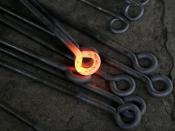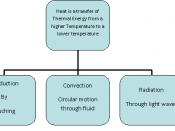Since evolution began Man has spread to all areas of the globe, his ability to regulate his body temperature independently of his external surroundings contributes significantly to this success. This assignment will discuss the methods by which heat is exchanged, the effect of this exchange on the body and how it is utilised in thermoregulatory mechanisms. The importance of these regulatory measures will be demonstrated by a brief description of the effects on the body when they do not function properly.
Body temperature is not constant, as discussed by Heath (2003), it fluctuates in accordance with endogenous and exogenous variables, such as metabolism and ambient temperature. Regulatory mechanisms help keep the core (internal) temperature within a narrow range of 36.1ðC to 37.8ðC (the 'set point'). To keep within this narrow range a balance must be maintained between heat loss and heat gain. The body has three mechanisms it can draw on to achieve this: generating its own heat, gaining heat from the environment and loosing heat to the environment.
This movement of heat between the body and surroundings occurs by conduction, convection, radiation and evaporation.
Movement by conduction requires two solid objects in direct contact with each other e.g. when standing barefoot heat will be conducted from the soles of the feet to the floor. This exchange will continue until contact is broken or equilibrium is reached, at this point the floor ceases to drain heat from the feet, acting instead as insulation. As a result, Clark & Edholm (1985) estimate the role of conduction in thermoregulation to be no greater than 2%.
Convection is the transfer of heat by a moving gas or liquid. Heat from the skin transfers to the surrounding air, as the air is heated is becomes less dense and rises to be replaced by cooler...


